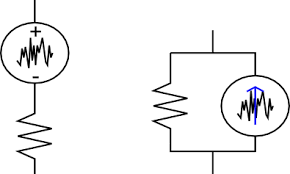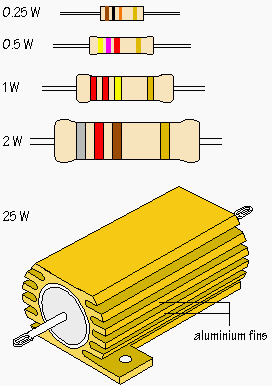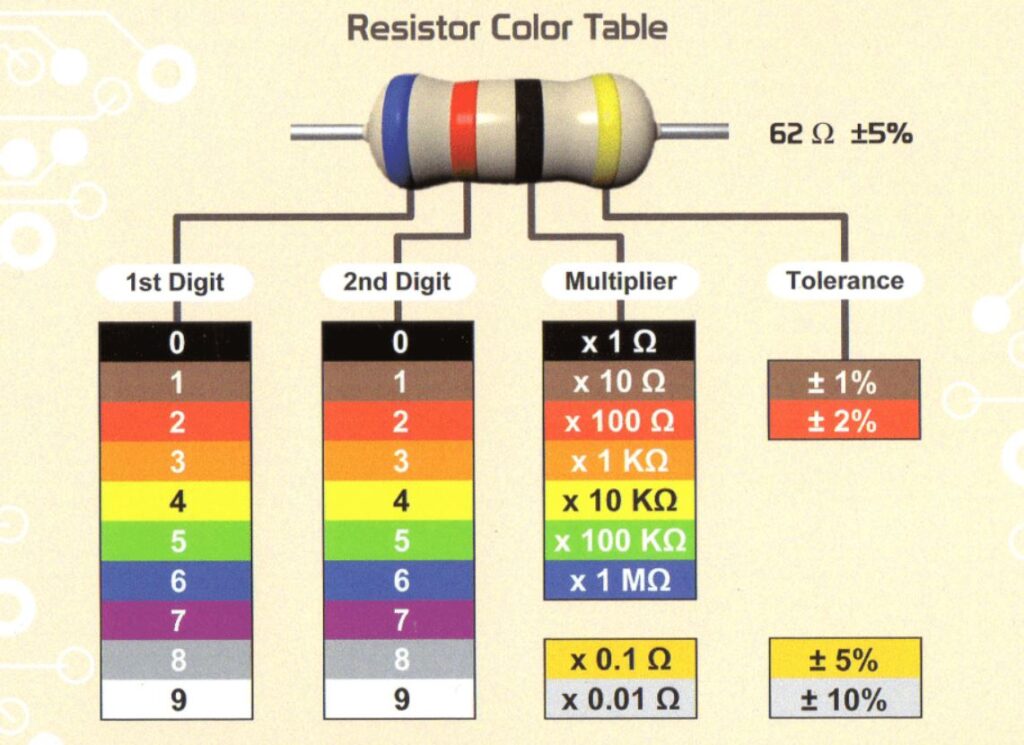What is resistor?
What is resistor ?
A resistor is a passive element in a circuit that provides resistance to the flow of current. Resistance is a measure of the opposition to the flow of current in a resistor. The larger a resistor’s resistance, the greater the barrier against the flow of current. There are many different types of resistors, such as a thermistor.
The unit of resistance is ‘Ohm’ and is represented as Ω. As per Ohm’s Law, When a 1 Volt potential difference is applied across a resistor and 1 Amp of current flows through it, the resistance of the resistor is said to equal 1 Ω. A resistor is one of the most fundamental circuit elements in electrical and electronics engineering.
Applications of Resistor :
We often need to introduce electrical resistance into a circuit to limit the amount of current passing through it. A resistor is a circuit element that does just that. For example, you may set up a bunch of resistors in series to limit the current flowing through a light emitting diode (LED).
In addition to that resistors serve many other purposes in electrical and electronic applications. The most essential requirement of a resistor is that its value of electrical resistance should not vary with temperature (except for a thermistor, which is designed to change its resistance with temperature).
For a basic resistor though, the resistance should not vary with temperature – even with large temperature fluctuations. In other words, the temperature coefficient of resistance must be minimized. Resistors are also frequently used in many electronics projects, and hence come included in many of the best Arduino starter kits.

High Frequency Effects on Resistor :
The effective resistance value of a resistor may be changed when it is subjected to alternating voltage. Not only that the value of resistance varies with the variation of frequency of supply voltage. This change of resistance with frequency is called the Boella effect. Actually it is not practically possible to make an ideal resistor.
Practically it may have some inductor and capacitance in addition to its resistance. Therefore, the value of the impedance of the resistor may vary with frequency. That is why a resistor is referred to be used within its useful frequency range. The useful frequency range is defined as the highest frequency limit beyond which the impedance of the resistor crosses its tolerance value.
The high-frequency effect on resistors depends upon its constructional feature. The impedance of a wire-wound resistor increases with frequency. On the other hand composition resistor reduces its impedance with increasing frequency. The impedance of film resistors does not change up to 100 MHz and then it decreases. Film resistors have the most stable high-frequency performance.
The high-frequency response of a resistor may also depend up to some extent on the diameter of the resistor. It is seen that a smaller diameter resistor has a better frequency response. Because of that the length – diameter ration of high-frequency resistors is between 4:1 to 10:1.
Voltage Coefficient of Resistance :
The resistance of a resistor may also vary sometime with the applied voltage across it. This change is expressed as a percentage of the resistance at 10 % of rated voltage. Thus the voltage coefficient of resistance is given by:

Where R1 is the resistance at the rated voltage V1 and R2 is the resistance at 10% of rated voltage V2.
Noise of a Resistor :
Noise in a resistor is caused by its applied voltage, its physical dimensions, and materials by which it is made. The noise includes Johnson noise, noise due to flow of current, noise due to cracked bodies, and noise due to loosening end caps and leads of the resistor. For variable resistors the noise can also be caused by the jumping of a moving contact overturns and by an imperfect electrical path between the contact and resistance element.

Johnson noise is thermal noise. This noise depends upon temperature but does not depend upon frequencies. As this noise is the same for all frequencies it is referred to as “white noise”. The magnitude of thermal noise is given by,
Where, ERMS is the value of the noise voltage (V) in RMS, R is the resistance measured in ohm, k is Boltzmann constant (1.38 × 10 – 23 J/K), T is the temperature measured in Kelvin, and Δf is the bandwidth in Hz over which the noise energy is measured.

Power Rating of Resistor :
When current passes through a resistor there would be I2R loss and hence as per Joules law of heating, there must be temperature rise in the resistor. A resistor must be operated within a temperature limit so that there should not be any permanent damage due to high temperature.
The power rating of a resistor is defined as the maximum power that a resistor can dissipate in the form of heat to maintain the temperature within the maximum allowable limit. How much power a resistor will dissipate depends upon the material, dimensions, voltage rating, maximum temperature limit of the resistor and ambient temperature.

Voltage Rating of Resistor :
This rating is defined as the maximum voltage that can be applied across a resistor due to which power dissipation will be within its allowable limit. Actually voltage rating of a resistor is related to the power rating. As we know that the power rating of a resistor is expressed as

Where V is the applied voltage across the resistor and R is the resistance value of the resistor in ohms.
From the above equation, it is clear that for limiting P, V must be limited for a particular resistor of resistance R. This V is voltage rating of a resistor of power rating P watts and resistance R Ω.
Resistor Color Code :
There are mainly four color bands provided on the body of resistors and each color indicates unique digit. Such as
Black ⇒ 0,
Brown ⇒ 1,
Red ⇒ 2,
Orange ⇒ 3,
Yellow ⇒ 4,
Green ⇒ 5,
Blue ⇒ 6,
Violet ⇒ 7
Gray ⇒ 8,
White ⇒ 9.
The first and second color bands indicate a two digits number. The 3rd color band indicates the power of ten as multiplier. The fourth band indicates the tolerance.
Note: We created a resistor color code calculator to make it easy for you to figure out the color code you need, or the resistance of your resistors (works for 3, 4, and 5 band resistors!).

Read article – Units of Resistivity
Visit NCERTplanet.com for NCERT solutions and Textbook downloads




